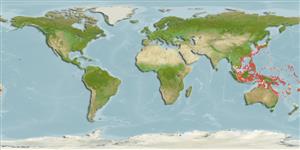Environment: milieu / climate zone / depth range / distribution range
Ecology
Marine; reef-associated; depth range 10 - 30 m (Ref. 90102). Subtropical
Western Pacific: Japan, New Guinea, Indonesia, Philippines, Sabah, Palau, and New Caledonia.
Size / Weight / Age
Maturity: Lm ? range ? - ? cm
Max length : 11.0 cm SL male/unsexed; (Ref. 48637)
Dorsal spines (total): 6 - 7; Dorsal soft rays (total): 11; Anal spines: 1; Anal soft rays: 10 - 11. Characterized by whitish body color; presence of dark band below eye; clusters of irregular brown spots covering body; 4-5 enlarged brown spots along ventral side; several diffuse brown bars on side; rear edge of dorsal fin with partially ocellated black spot; white coloration on basal portion of pectoral fin; triangular first dorsal fin without prolonged spines; united pelvic fins, well developed frenum present; longitudinal scale series 74-91; head without scales; body covered by cycloid scales; greatest depth of body 5.8-6.5 in SL; rounded caudal fin, a little shorter than head length; reduced posterior oculoscapular sensory canal, single pore (H') present (Ref. 90102).
Inhabits protected sand slopes (Ref. 37816). Lives in clear coastal and inner reefs on rubble flats and slopes (Ref. 48637). Found in burrows together with Alpheus bellulus. Depth range 10-30 (Ref 90102).
Life cycle and mating behavior
Maturity | Reproduction | Spawning | Eggs | Fecundity | Larvae
Masuda, H., K. Amaoka, C. Araga, T. Uyeno and T. Yoshino, 1984. The fishes of the Japanese Archipelago. Vol. 1. Tokai University Press, Tokyo, Japan. 437 p. (text). (Ref. 559)
IUCN Red List Status (Ref. 130435: Version 2024-2)
Threat to humans
Harmless
Human uses
Tools
Special reports
Download XML
Internet sources
Estimates based on models
Preferred temperature (Ref.
123201): 21 - 29, mean 27.8 °C (based on 158 cells).
Phylogenetic diversity index (Ref.
82804): PD
50 = 0.5000 [Uniqueness, from 0.5 = low to 2.0 = high].
Bayesian length-weight: a=0.00724 (0.00339 - 0.01546), b=3.10 (2.92 - 3.28), in cm total length, based on LWR estimates for this (Sub)family-body shape (Ref.
93245).
Trophic level (Ref.
69278): 3.4 ±0.4 se; based on size and trophs of closest relatives
Resilience (Ref.
120179): High, minimum population doubling time less than 15 months (Preliminary K or Fecundity.).
Fishing Vulnerability (Ref.
59153): Low vulnerability (10 of 100).
